
What is carbon capture?
Carbon dioxide (CO2) emissions generated by human activities have led to an accumulation of greenhouse gases in the atmosphere that is causing an increase in
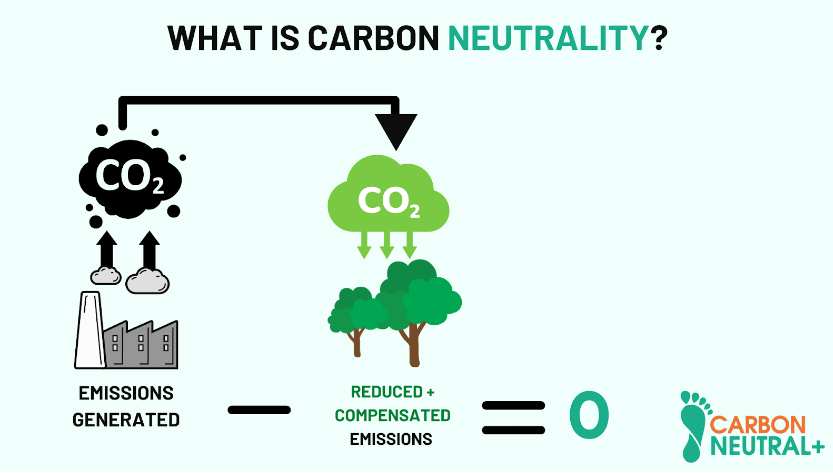
Climate change has become one of the biggest problems that humanity faces today. To respond to this situation, many organizations and countries are looking for ways to combat this phenomenon through mitigation strategies. One of the best ways to achieve this goal is carbon neutrality.
Carbon neutrality is the process of reducing or removing carbon emissions from an organization, industry or country so that the net amount of carbon released is zero. As of 2021, 124 countries around the world have already pledged to achieve carbon neutrality by 2050 or 2060.
In this article, we will tell you what carbon neutrality is, its advantages, future challenges, and possible mechanisms for its implementation. We will also discuss the concept of carbon offsetting and how it can be used to help achieve a company’s carbon neutrality goals.
What is carbon neutrality?
Carbon neutrality is the goal of reducing and offsetting the amount of carbon dioxide (CO2) released into the atmosphere by a company, event, person or institution.
Companies start by measuring its carbon emissions, then reducing the amount of CO2 equivalent emitted, and last offsetting the remaining emissions by investing in certified carbon offset projects.
Carbon neutrality can be achieved on a global scale or within a single organization, industry or country.
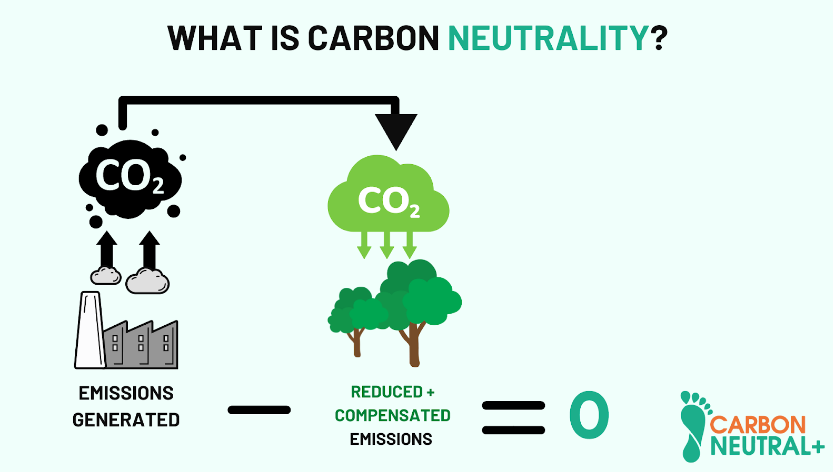
The process of achieving carbon neutrality involves identifying the sources of carbon emissions, quantifying them, setting a reduction target and implementing reduction strategies. This requires investments in green technologies and renewable energy, as well as changes in operational practices and employee and consumer behaviors.
Why is it important to achieve carbon neutrality by 2050?
The main goal of achieving carbon neutrality by 2050 is to limit the Earth’s temperature increase to 1.5-2 degrees Celsius by the end of the century (2100) with respect to pre-industrial levels.
Although the Earth’s temperature has risen by approximately 1.1C, sea level rise has been 0.24m. Under the current scenario, the expected projection for 2100 is that this rise will be 0.3-1.5m. This will depend on the fossil fuel use scenario at that time.
The only way to stop temperature and sea level rise is to reduce atmospheric concentrations of CO2. The goal is to bring this level as close as possible to its pre-industrial values. This forces not only the world’s companies and cities to compensate for all their emissions, but also to increase the number of CO2 sinks in order to reverse this situation.
The following graph shows the evolution of CO2eq concentration in the atmosphere from 1958:
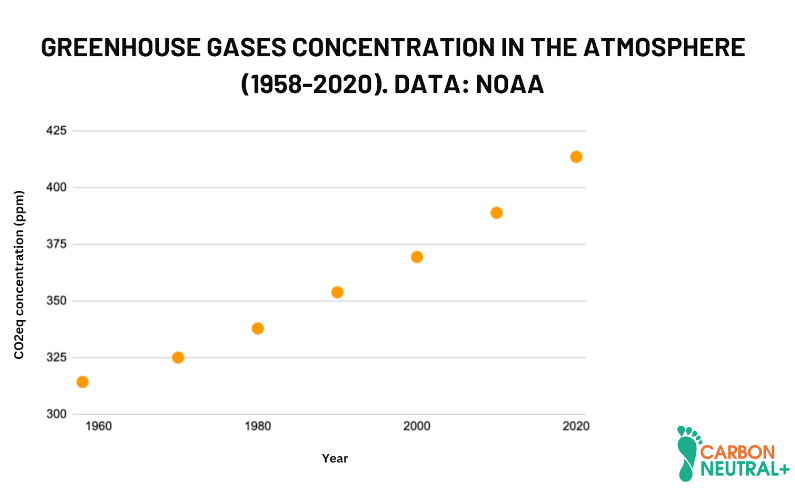
Achieving carbon neutrality has multiple benefits for organizations, industries and countries. Some of these include not only environmental benefits but also social, economic and business benefits, as carbon neutrality allows to:
Achieving carbon neutrality is not free of challenges. One of the biggest is cost. This is because the technologies and practices needed to reduce carbon emissions can be expensive, and many organizations and countries lack the financial resources to invest in them.
In addition, there are also challenges related to public acceptance and will. Many of the changes needed to reduce emissions may be unpopular and difficult to implement, and there may be resistance from stakeholders.
There are also technical challenges related to measuring and verifying emissions. Many organizations have difficulties to accurately measure their emissions, making it difficult to set reduction targets and track progress.
In addition, there are also challenges related to data collection and reporting, as many countries have different regulations and standards for collecting and reporting emissions data.
In order for a company to achieve carbon neutrality, there are different tools and steps to follow:
Below we will tell you more about how to implement each of these steps and become a carbon neutral company:
To achieve carbon neutrality, organizations and countries must first calculate their carbon footprint. The carbon footprint is the total amount of carbon equivalent emissions released by an organization or country over a given period of time. It is calculated by determining the emissions from each source, such as electricity, transportation and waste disposal.
Carbon footprint calculation is a complex process, and organizations should be aware of all sources of emissions. In addition, organizations should also be aware of the different types of emissions, such as direct emissions from operations, indirect GHG emissions associated with electricity and other indirect GHG emissions.
If you want to calculate your corporate carbon footprint, you can access our free carbon footprint measurement tool. Simply enter the data of your company’s activities to estimate how many emissions they generate and thus quantify your contribution to climate change.
The second step to achieving carbon neutrality is to reduce the previously calculated CO2 emissions as much as possible.
Organizations and countries can reduce their emissions by making changes in their operations. This includes changing consumer behaviors, such as reducing the use of vehicles and encouraging the use of public transport, as well as changing operational practices, encouraging the treatment of usable waste and eliminating single-use plastics.
Another option is to invest in renewable energy sources, such as solar and wind power. This can help reduce emissions and create jobs in the green energy sector. Prior to this, it is recommended that organizations also reduce their emissions by implementing energy efficiency measures, such as installing energy-efficient lighting and appliances.
In order to reduce your emissions associated with electricity use, the simplest option is to purchase renewable energy certificates. However, there are other options that you can find in our article: How to use renewable energy in your company?
Carbon credits or carbon offsets, allow companies to achieve carbon neutrality by compensating for emissions that cannot be reduced through internal reduction actions.
Offset actions are investments in activities that reduce carbon emissions through CO2 removal or reduction projects. These activities can range from reforestation to investing in renewable energy projects. These investments are also commonly referred to as carbon credits.
Carbon credits are an essential tool in the fight against climate change. This is because they can not only help reduce global emissions, but also provide economic benefits to the communities where they are implemented.
In this way, carbon offsets can help organizations and countries achieve their carbon neutrality goals by providing a way to offset their emissions while continuing to invest in green technologies and renewable energy.
Some options of projects in which you can invest to offset your carbon emissions are:
Also, organizations can invest in projects that reduce emissions in developing countries, which can help reduce global emissions and improve global sustainability.
From our marketplace, you can access the purchase of carbon credits to finance all these types of projects.
Achieving carbon neutrality is an important step in the fight against climate change. It can reduce emissions, improve air quality and protect biodiversity. It can also help organizations and countries reduce their operating costs, improve their public image and meet their sustainability goals.
To achieve carbon neutrality, organizations and countries must identify their sources of emissions, set reduction targets, and implement strategies to reduce emissions. Finally, they must offset those emissions that cannot be reduced through mitigation strategies.
Historically, the industrial revolutions that humanity has undergone have improved living standards at the expense of the exploitation of our natural resources. Much of that exploitation is due to the use of fossil fuels to achieve the technological development we have achieved today. However, the use of these fuels not only contributes to global warming but also to the degradation of our environment.
The current industrial revolution, called the “green industrial revolution”, can solve these problems. Carbon neutrality is undoubtedly the first step towards a sustainable future, where nature and humans can coexist harmoniously.
For more information, please contact our specialist team.
Wang, F. et al.Technologies and perspectives for achieving carbon neutrality. The innovation (2021).
Wu, X. et al. A review of the theoretical research and practical progress of carbon neutrality. Sustainable Operations and Computers (2022).
Chen, J.M. Carbon neutrality: Toward a sustainable future. The innovation (2022).

Carbon dioxide (CO2) emissions generated by human activities have led to an accumulation of greenhouse gases in the atmosphere that is causing an increase in
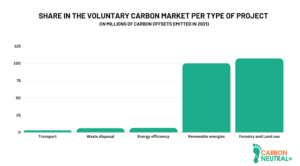
According to the Emissions Gap Report 2022, the growth rate of global greenhouse gas (GHG) emissions has declined over the last decade. Between 2010 and
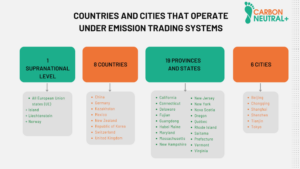
As international agreements related to corporate greenhouse gas emissions (GHG) come into force, the regulations associated with the generation of these emissions increase. This is
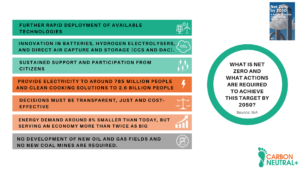
Climate change is one of the greatest concerns of our time. This phenomenon is generating consequences that are difficult to reverse, such as an increase

The Paris Agreement is an international agreement adopted on December 12, 2015 during the United Nations Climate Change Conference (COP21) in Paris, France. One of
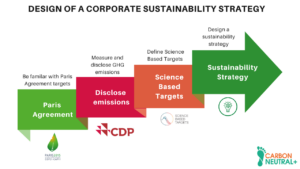
As the world faces the looming effects of climate change, more and more companies are recognizing the importance of adopting sustainable strategies that aim to
| Cookie | Duration | Description |
|---|---|---|
| cookielawinfo-checkbox-analytics | 11 months | This cookie is set by GDPR Cookie Consent plugin. The cookie is used to store the user consent for the cookies in the category "Analytics". |
| cookielawinfo-checkbox-functional | 11 months | The cookie is set by GDPR cookie consent to record the user consent for the cookies in the category "Functional". |
| cookielawinfo-checkbox-necessary | 11 months | This cookie is set by GDPR Cookie Consent plugin. The cookies is used to store the user consent for the cookies in the category "Necessary". |
| cookielawinfo-checkbox-others | 11 months | This cookie is set by GDPR Cookie Consent plugin. The cookie is used to store the user consent for the cookies in the category "Other. |
| cookielawinfo-checkbox-performance | 11 months | This cookie is set by GDPR Cookie Consent plugin. The cookie is used to store the user consent for the cookies in the category "Performance". |
| viewed_cookie_policy | 11 months | The cookie is set by the GDPR Cookie Consent plugin and is used to store whether or not user has consented to the use of cookies. It does not store any personal data. |